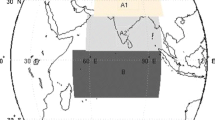Abstract
This paper reports the results of a Bayesian-based algorithm for the retrieval of hydrometeors from microwave satellite radiances. The retrieval technique proposed makes use of an indigenously developed polarized radiative transfer (RT) model that drives a data driven optimization engine (Bayesian) to perform retrievals of rain and other hydrometeors in a multi-layer, plane parallel raining atmosphere. For the sake of completeness and for the purposes of comparison, retrievals with Artificial Neural Networks (ANN) have also been done. Retrievals have been done first with a simplified two-layer atmosphere, where assumed values of hydrometeors are given to the forward model and these are taken as ‘measured radiances’. The efficacy of the two retrieval strategies is then tested for this case in order to establish accuracy and speed. The highlight of the work is however, the case study wherein a tropical storm in the Bay of Bengal is taken up, to critically examine the performance of the retrieval algorithm for an extreme event wherein a 14-layer realistic, raining atmosphere has been considered and retrievals are done against Tropical Rainfall Measuring Mission (TRMM) measured radiances. The key novelties of the work are:
-
inclusion of polarization from both hydrometeors and oceans in the RT model, and
-
populating the database involving atmospheric profiles vs. simulated radiances by profiles of similar rain events in the past.
In this work, the database was populated with TRMM retrieved profiles for tropical cyclones that occurred earlier in the area of interest (Indian Ocean), rather than with the Goddard Cloud Ensemble profiles. The use of (i) polarization in the forward model and (ii) creation of an a priori database for the retrieval denote the significant departure from the current state-of-the-art in the area.
Similar content being viewed by others
References
Deiveegan M 2007 Precipitation retrieval using a polarized microwave radiative transport model, Ph.D. Thesis, Department of Mechanical Engineering, Indian Institute of Technology Madras, India.
Deiveegan M, Balaji C and Venkateshan S P 2008 A polarized microwave radiative transfer model for passive remote sensing; Atmos. Res. 88 277–293.
Evans K F and Stephens G L 1991 A new polarized atmospheric radiative transfer model; J. Quantitative Spectroscopy and Radiative Transfer 46 413–423.
Hagan M T and Menhaj M B 1994 Training feed forward nets with the Marquardt algorithm; IEEE Transactions on Neural Network 5 989–993.
Kummerow C, Olson W S and Giglio L 1996 A simplified scheme for obtaining precipitation and vertical hydrometeor profiles from passive microwave sensors; IEEE Transactions on Geosciences and Remote Sensing 34 1213–1232.
Lippmann R P 1987 An introduction to computing with neural nets; IEEE ASSP Magazine 4 4–22.
Marquardt D W 1963 An algorithm for least-squares estimation of nonlinear parameters; J. Soc. Industrial and Applied Mathematics 11 431–441.
Marzano F S, Mugnai A, Panegrossi G, Pierdicca N, Smith E A and Turk J 1999 Bayesian estimation of precipitating cloud parameters from combined measurements of space borne microwave radiometer and radar; IEEE Transactions on Geoscience and Remote Sensing 37 596–613.
Nguyen D and Widrow B 1990 Improving learning speed of 2-layer neural networks by choosing initial values of the adaptive weights; International Joint Conference of Neural Networks 3 21–26.
Peterson C, Roghvaldsson T and Lonnblad L 1994 JETNET 3.0, A versatile artificial neural network package; Computer Physics Communications 81 185–220.
Petty W G 2001 Physical and Microwave Radiative Properties of Precipitating Clouds. Part I: Principal Component Analysis of Observed Multichannel Microwave Radiances in Tropical Stratiform Rainfall; J. Appl. Meteorol. 40(12) 2105–2114.
Srinivasan J 2006 MEGHA TROPIQUES Scientific Rationale, First Workshop on Megha-Tropiques organized by Indian Space Research Organization (ISRO), Indian Institute of Science (IISc), Bangalore.
Author information
Authors and Affiliations
Corresponding author
Rights and permissions
About this article
Cite this article
Balaji, C., Deiveegan, M., Venkateshan, S.P. et al. Retrieval of hydrometeors from microwave radiances with a polarized radiative transfer model. J Earth Syst Sci 119, 97–115 (2010). https://doi.org/10.1007/s12040-010-0005-x
Received:
Revised:
Accepted:
Published:
Issue Date:
DOI: https://doi.org/10.1007/s12040-010-0005-x




